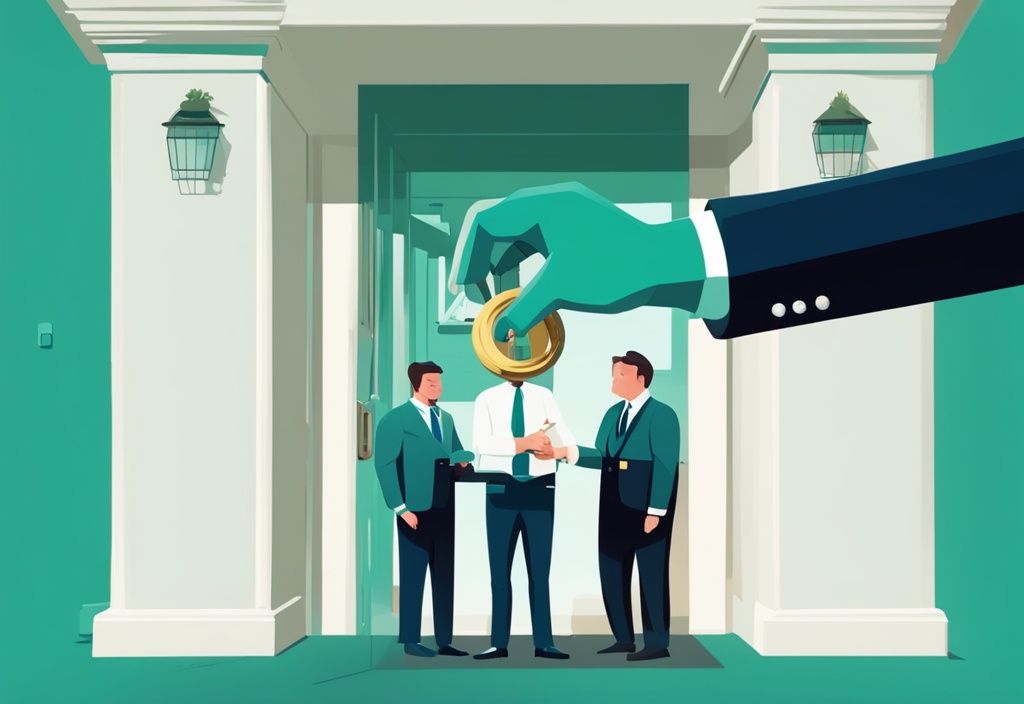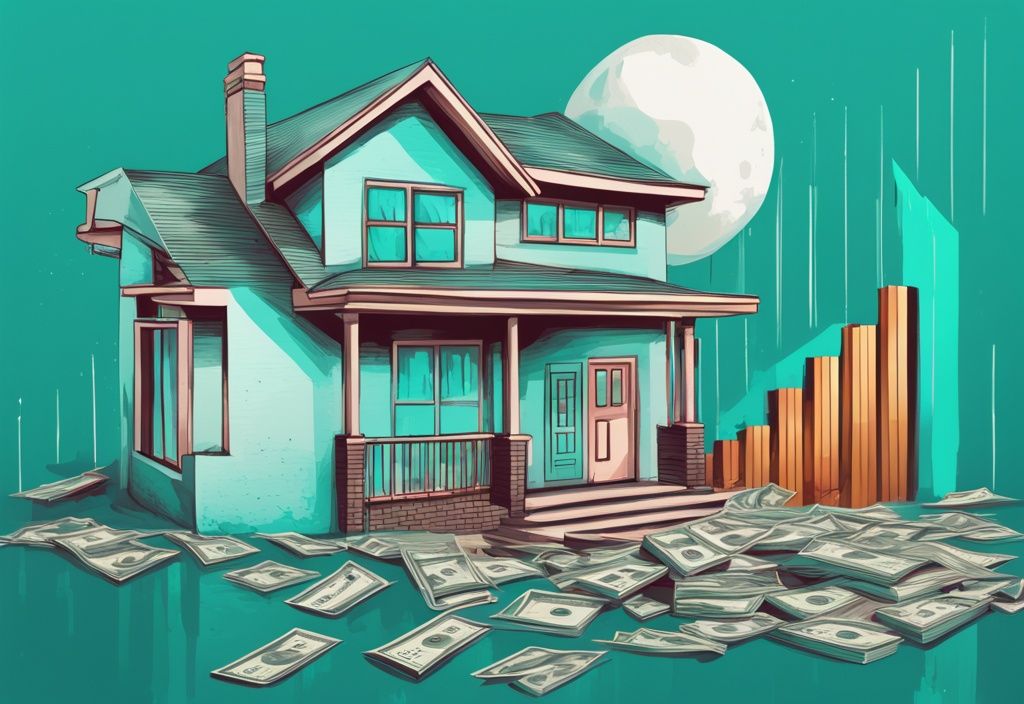Ever thought of wading into the lucrative waters of real estate but got discouraged by the hefty capital associated with it? Trust me, you’re not alone! I’m Alex Harper, your guide in the seemingly complex yet ultimately rewarding universe of property investment. Here’s the exciting news: You don’t need a money tree to start this journey.
Throughout this enlightening article, we’ll uncover the not-so-secret tricks of the trade. You’re about to discover how to leverage creative financing strategies, use other people’s money, and take your first -or next- steps in real estate investing.
Ready to defy traditional investment norms and build a thriving real estate portfolio without dipping into your own savings? Then strap in and let’s dive deep into this fact-filled guide! You’re one click away from making an informed leap into real estate.
Breaking Down the Idea of No Money Down Investing
Understanding the concept of investing in real estate with little to no personal financial outlay hinges on creative financing and leveraging other people’s money (OPM). The strategies here allow you to get into the market with minimal out-of-pocket expenses. The term “no money down” can be somewhat misleading, as the funds still need to come from somewhere, just not from your pocket. Let’s delve into how you can effectively minimize your personal financial contribution while using external resources to acquire properties.
No Money Down: Unpacking the Phrase
Investing in real estate with no money down essentially means using creative financing methods or other people’s funds (OPM) to acquire properties. By minimizing your own financial input and utilizing borrowed funds or forming partnerships, you can enter the real estate market efficiently. Even though the phrase “no money down” suggests otherwise, the required funds must come from external sources—be it loans, partnerships, or other financial strategies.
Using Other People’s Money (OPM) for an Investment
One primary strategy for investing without using your own money is leveraging OPM. This can be done through:
- Private Money Lenders: Individuals who lend money based on personal terms.
- Partnerships: Teaming up with other investors to pool resources.
- Hard Money Lenders: Short-term, high-interest loans based on property value.
- Seller Financing: The seller financing some of the purchase price, making traditional bank financing less necessary.
These strategies help spread the financial risk and allow you to engage in lucrative real estate deals without needing substantial capital from your own funds.
Is ‘No Money Down’ an Actual Possibility?
It might seem challenging to invest with zero of your own money, but it is feasible with minimal personal financial outlay. Creative financing, strategic planning, and building relationships with potential lenders or partners are crucial. Leveraging a mix of financial products and fostering strong connections can enable you to venture into real estate investing without a significant upfront personal expense.
To successfully invest in real estate with no money, you need a deep understanding of financial instruments along with the ability to form beneficial relationships.
This approach can truly open up the possibilities for engaging in real estate investments without heavy personal financial burdens.
Requirements for Successful Investing with No Money Down
Real estate investing without a large upfront financial commitment might sound daunting, but it’s entirely possible with the right strategies. Here, we’ll cover the critical elements required for making successful investments without significant capital.
The Role of Credit Score in Real Estate Investing
Your credit score is a pivotal factor in determining your ability to secure favorable lending terms. For anyone diving into how to invest in real estate with no money, maintaining a good credit score becomes even more crucial. A strong credit score can increase your eligibility for loans and influence the interest rates and repayment conditions offered by lenders.

Improving your credit score isn’t as complicated as it seems. Think of it like nurturing a plant: consistently paying your bills on time is like regular watering, demonstrating financial responsibility to potential lenders. Reducing existing debts is akin to trimming dead leaves, which can significantly boost your credit rating. Regularly monitoring your credit reports is like checking for pests—it allows you to catch and correct inaccuracies, ensuring your credit profile remains healthy.
How to Maintain Healthy Finances for Investing
Maintaining robust financial health is integral when exploring how to invest in real estate with no money.
Picture your financial health like a tree; its roots represent your emergency fund, providing a safety net for unforeseen expenses and financial stability. This fund should be separate from your real estate investments.
Managing debts and living expenses effectively is like pruning back branches—it ensures you’re not overleveraged and can meet financial commitments. Considering mortgage insurance or refinance options provides additional benefits. Think of these as a special fertilizer; they can give you more favorable loan terms, reducing the cost of borrowing and improving your investment potential. Keeping your personal finances in check creates a stable foundation for sustainable investing strategies.
Fostering Relationships: The Network Effect
Networking plays an essential role in how to invest in real estate with no money. It can be compared to building a support system, like the branches of a tree that support each other. A robust network can open doors to potential lenders, partners, and lucrative investment opportunities.
Engage with real estate investment groups (REIGs), participate in crowdfunding platforms, and join professional networks to make valuable connections. These relationships can be crucial in finding investors willing to finance your deals or offer partnerships. Collaborating with seasoned real estate professionals is like grafting a strong branch onto your tree, imparting invaluable knowledge and resources, further enhancing your strategy.
By fostering strong relationships within the industry, you expand your opportunities, making it easier to navigate the complexities of real estate investment with minimal personal financial input.
Strategic Methods for Real Estate Investment with No Money Down
Delving into the realm of real estate investing without any cash upfront might seem like a daunting task, but trust me, it’s entirely possible with the right strategies. Let’s explore various approaches that can help you get started with little to no money down.
Exploring House Hacking
House hacking is a versatile approach for those wondering how to invest in real estate with no money. This strategy involves purchasing a property, residing in a portion of it, and renting out the remaining space to cover mortgage expenses. It significantly reduces the financial burden on the investor, allowing them to live at a minimal cost while building equity.
Investing in Multi-Family Properties
A popular house hacking technique is investing in multi-family properties. By purchasing a multi-family home and living in one of the units, you can rent out the other units to generate income. This method is particularly effective for beginners, as it provides an immediate source of rental income while reducing living costs.
An Insight into Renting Out Rooms
For those not ready to take the plunge into multi-family properties, renting out rooms in a single-family home is another viable option. Purchasing a single-family residence and renting out individual rooms can quickly cover mortgage and maintenance expenses. This approach allows first-time buyers to leverage their primary residence for income generation, making it a practical starting point for entry into real estate investing.
Utilising Home Equity for Investing
Homeowners often overlook the potential of leveraging existing home equity to finance investment properties. This method involves using the accumulated value in your home as a financial tool for further investments.
Home Equity Loan
A Home Equity Loan is a lump-sum loan borrowed against the equity in your home. This type of loan is typically offered with fixed interest rates and set repayment terms, providing a predictable and straightforward method of financing additional property acquisitions.
Line of Credit: The Basics of Home Equity
A Home Equity Line of Credit (HELOC) offers a more flexible alternative to a home equity loan. Acting as a revolving line of credit secured against your property, a HELOC allows you to draw funds as needed, offering adaptable financial support for real estate investments.
What is Cash-Out Refinance?
Cash-Out Refinance is another way to utilize home equity. This method involves refinancing your mortgage for more than you currently owe and taking the difference in cash. It enables homeowners to invest in additional real estate while keeping mortgage payments manageable, thereby expanding their investment portfolio without significant upfront costs.
The Power of Partnering for Real Estate Investment
Forming partnerships is an effective way to pool resources and mitigate risks in property investments. Collaborating with others can provide the capital and expertise needed to succeed in the competitive real estate market.
Engaging Co-Borrowers
One partnership strategy involves engaging co-borrowers. Partnering with another individual to combine financial resources and creditworthiness can help secure loans that might be unattainable individually. Co-borrowers share ownership, responsibilities, and profits from the property investment, making this an equitable arrangement for both parties.
Exploring Equity Partnerships
Equity partnerships are another collaborative strategy where investors contribute capital in exchange for a percentage of ownership and profits. This method is particularly useful for investors who excel at finding lucrative deals but lack the required capital. By understanding concepts such as subject to in real estate transactions, investors can better navigate the complexities of property investments. By pooling resources, both parties benefit from the investment’s success.
Benefiting from Government Loans and Programs
Government-backed loans and programs can offer favorable terms for first-time homebuyers and specific demographics, making them an attractive option for investors looking to minimize personal financial outlay.
USDA Loans: Your Guide to Real Estate Investing
USDA loans are targeted at rural areas and require zero down payment, providing low-interest rates to qualified buyers. These loans are ideal for those purchasing property in qualifying rural regions, expanding investment opportunities beyond urban settings.
FHA Loans & How They Can Aid Your Investment
FHA loans cater to buyers with lower credit scores and require a smaller down payment compared to conventional loans. These loans are particularly useful for first-time homebuyers who plan to transition their primary residence into a rental property, facilitating the entry into real estate investment with limited initial funds.
Investing in Real Estate through VA Loans
For veterans and active-duty military members, VA loans offer excellent terms, including no down payment. These loans can be used to purchase multi-family properties, allowing investors to live in one unit while renting out others. This strategy maximizes the benefits of government support while building a real estate portfolio.
Untraditional Financing Methods: Expanding Your Possibilities
Unconventional financing options can open up various pathways to property acquisition, enabling investors to think outside the box and extend their investment capabilities.

A Closer Look at Hard Money Lenders
Hard money lenders provide short-term loans based on the property value rather than the borrower’s credit score. While these loans come with higher interest rates and shorter terms, they offer quick access to funds, making them suitable for investors needing swift capital for time-sensitive opportunities.
Private Money Lenders
Private money lenders are individuals or private entities offering loans outside traditional banking systems. These loans often come with flexible terms and higher interest rates. Specific lending criteria apply, but these can be tailored to suit the investor’s needs, offering a viable alternative to conventional financing.
Utilising Gap Lenders
Gap lenders provide financing to cover down payments, facilitating property acquisitions without immediate substantial cash outlay. In return, gap lenders typically receive a share of the equity or profits, helping bridge the financial gap for investors looking to maximize their real estate portfolios.
Creative Financing Techniques
Creative financing techniques offer novel ways to acquire properties with limited personal capital, allowing investors to leverage various strategies to minimize upfront costs.
Assuming Existing Mortgages: An Untapped Technique
Assuming an existing mortgage involves transferring the seller’s mortgage to yourself, requiring minimal changes to the loan terms. This technique is particularly useful when the existing mortgage features favorable rates, allowing you to step into beneficial financial terms without the need for extensive negotiations.
How to Leverage Credit Cards for Investing
In some scenarios, leveraging credit cards can cover small, immediate costs such as closing fees or minor renovations. While risky due to high-interest rates, this method can be beneficial for short-term financial gaps, providing quick access to the funds required to close deals or enhance property value.
Hurdles on the Path to No-Money Down Investing
Embarking on a journey to invest in real estate with no money often sounds like a dream, but it comes with unique challenges. Below, let’s navigate through some of the main hurdles you might face and how to tackle them effectively.
Financial Risks: Managing the Highs and Lows
Investing in real estate with no money down often leans heavily on leverage. This can amplify both your potential returns and risks. Imagine leverage as a double-edged sword. On one side, there’s the possibility of high returns. On the other, there’s the risk of financial instability if property values drop or rental income falls short of covering loan payments. This is why having a robust contingency plan is a lifesaver.
Think of setting up an emergency fund as your financial safety net. It’s there to catch you during unforeseen expenditures or economic downturns. Ensuring you have this fund means you’ll be in a stronger position to weather any unexpected property-related expenses without jeopardizing your investment.
Navigating Negative Cash Flow Scenarios
Experiencing a negative cash flow means your property’s operating expenses and mortgage payments exceed the income it generates. This can put a serious strain on your finances. Before diving into a purchase, conducting thorough due diligence and cash flow analysis is paramount.
It’s like knowing all the ingredients before you start cooking. You need to understand all expenses, from maintenance costs to vacancy rates. This clarity helps you anticipate profitability accurately. Adequate forecasting and strategic planning are key to mitigating negative cash flow risks, ensuring your investment remains profitable over time.
Operating within Lender Dynamics
Securing financing without a substantial down payment can be challenging. Lenders usually favor borrowers with strong financial profiles, high credit scores, and significant down payments. Without substantial personal capital, you might need to sweeten the deal – think higher interest rates or equity stakes.
Building solid relationships with lenders and showcasing your financial management skills can increase your chances of getting favorable loan terms. It’s a bit like dating; the better you present yourself and your financial stability, the more attractive you become to lenders.
Crucial Aspects to Consider Before Investing
Before you dive into real estate, it’s essential to cover a few basics that will set you up for success. Here’s what you need to know:
Evaluating Financial Health: A Crucial Step
When figuring out how to invest in real estate with no money, the first step is evaluating your financial health. Start by taking a thorough look at your current financial status—like checking your debts, savings, and credit score. Knowing exactly where you stand financially will help you make smart decisions and avoid over-leveraging.
It’s also vital to have an emergency fund. This safety net will help cover unexpected expenses without putting your real estate plans at risk. And keep your debt levels manageable, since too much debt can block future financing opportunities and ramp up your financial risk.
Understanding Your Risk Appetite
Investing in real estate, especially with no upfront money, carries inherent risks. That’s why understanding your risk appetite is crucial. Think about how comfortable you are with potential financial setbacks and align your strategies accordingly.
If you prefer a conservative approach, consider low-risk routes like government-backed loans. On the other hand, if you’re more aggressive, leveraging partnerships or hard money lenders might be the way to go. Knowing your risk tolerance helps you choose strategies that won’t keep you up at night.

Developing Long-Term Investment Goals
Setting clear long-term goals is key to success in real estate investment. Are you aiming for immediate income, long-term wealth, or maybe flipping properties? Define what you want to achieve.
For instance, short-term goals could be about buying your first rental property or hitting a specific cash flow target within a year. Longer-term, you might aim to build a diversified property portfolio or reach a set net worth through real estate. Having these goals in place helps you focus and measure your progress.
Market Research and Due Diligence: An Investment Essential
Thorough market research is essential, especially when learning how to invest in real estate with no money. Analyze the markets you’re interested in to gauge property values, rental yields, and the overall economic climate. Use resources like property listings, market reports, and local real estate agents to gather the data you need.
Due diligence is just as important—think of it like a security check for your investment. Review prospective properties thoroughly, look at historical data, and understand local regulations. This minimizes financial risk and sets you up for profitable, sustainable investments.
By focusing on these crucial aspects, you can confidently navigate the world of real estate investment, even if you’re starting with no money. Remember, thorough preparation and clear goals are your best tools for success.
In Summary
Understanding how to invest in real estate with no money is a game-changer for aspiring investors. This method taps into creative financing, utilizing other people’s money (OPM) to facilitate property acquisitions. Let’s explore the key elements that make this strategy work:
- Creative Strategies and OPM: Creativity and strategic planning are the core of no money down real estate investment. By leveraging OPM, one can secure funds from private lenders, partnerships, hard money lenders, or seller financing, reducing the need for personal capital. This paves the way for investing in properties even with limited personal resources.
- Various Pathways: There are several paths to support this investment strategy. House hacking, for instance, involves buying a property, living in part of it, and renting out the rest. Government-backed loans like USDA, FHA, and VA loans offer favorable terms to lower the down payment requirements. Moreover, utilizing home equity through loans, lines of credit, or cash-out refinance can provide the necessary funds without requiring out-of-pocket expenses.
- Strategic Planning and Networking: Success in no money down investing hinges on thorough planning and diligent networking. Building strong relationships within real estate groups, leveraging crowdfunding platforms, and partnering with experienced professionals can reveal valuable investment opportunities. Additionally, conducting comprehensive market research and due diligence ensures informed decisions, boosting the potential for profitable ventures.
In conclusion, while investing in real estate with no out-of-pocket expense can be challenging, applying these strategies with an entrepreneurial spirit can significantly lower financial barriers. By blending creative approaches, strategic planning, and networking, the dream of investing in real estate with no money becomes attainable.
FAQ: Tackling your Queries
Is a No-money-down Real Estate Investment Feasible?
- Absolutely! Using creative financing strategies, forming partnerships, and tapping into other people’s money (OPM) can make investing with little or no personal funds possible. The crucial part is finding willing financiers and structuring your deals to mitigate risks while maximizing returns.
What Risks Accompany a No-money-down Investment?
- No-money-down investments can be riskier due to the reliance on leverage and external financing. If rental income doesn’t cover your expenses, you might face negative cash flow and subsequent financial strain. That’s why having a robust contingency plan in place is essential.
Can I Use My Credit Card for Real Estate Investment Costs?
- Yes, but with caution. Credit cards can handle minor costs like closing fees and initial renovations. However, due to their high-interest rates, they shouldn’t be your main financing method. Reserve them for short-term expenses that you can quickly pay off.
Improving Credit Score: Methods
- Boosting your credit score involves timely bill payments, reducing outstanding debts, and regular credit report monitoring for any inaccuracies. A higher credit score gives you access to better financing options, simplifying and making real estate investing more cost-effective.
An Introduction to the BRRRR Method in Real Estate
- The BRRRR method—Buy, Rehab, Rent, Refinance, Repeat—revolves around purchasing distressed properties, renovating them, renting them out, refinancing based on their enhanced value, and repeating the cycle. This strategy is fantastic for systematically building a real estate portfolio while optimizing returns.
Hi, I’m Alex Harper, a real estate expert with over ten years of experience in property management and legal advice. My passion is making the often complicated world of real estate understandable. I share practical tips and simple solutions to help you make better decisions – whether you’re buying a home, renting or just want to learn more about the industry. With my knowledge and experience, I want you to feel well-informed and confident in your real estate projects. Let’s tackle this together!




